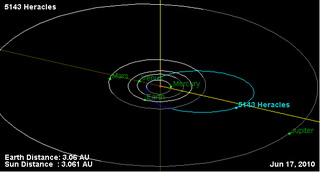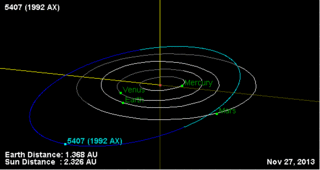Related Research Articles

4183 Cuno, provisional designation 1959 LM, is an eccentric, rare-type asteroid, classified as near-Earth object and potentially hazardous asteroid of the Apollo group, and measures approximately 4 kilometers in diameter.

2100 Ra-Shalom is an asteroid and near-Earth object of the Aten group on an eccentric orbit in the inner Solar System. It was discovered on 10 September 1978, by American astronomer Eleanor Helin at the Palomar Observatory, California, who named it in commemoration of the Camp David Peace Accords. The C-type asteroid has a rotation period of 19.8 hours and measures approximately 2.7 kilometers in diameter.

1627 Ivar is an elongated stony asteroid and near-Earth object of the Amor group, approximately 15×6×6 km. It was discovered on 25 September 1929, by Danish astronomer Ejnar Hertzsprung at Leiden Southern Station, annex to the Johannesburg Observatory in South Africa. It was named after Ivar Hertzsprung, brother of the discoverer. 1627 Ivar was the first asteroid to be imaged by radar, in July 1985 by the Arecibo Observatory.
1863 Antinous, provisional designation 1948 EA, is a stony asteroid and near-Earth object, approximately 2–3 kilometers in diameter. It was discovered on 7 March 1948 by American astronomer Carl Wirtanen at Lick Observatory on the summit of Mount Hamilton, California. It was named after Antinous from Greek mythology.

3752 Camillo is an inclined contact-binary asteroid, classified as near-Earth object of the Apollo group, approximately 2.3 kilometers in diameter. It was discovered on 15 August 1985, by astronomers Eleanor Helin and Maria Barucci using a 0.9-metre (35 in) telescope at the CERGA Observatory in Caussols, France. Lightcurve studies by Petr Pravec in 1998 suggest that the assumed S-type asteroid has an elongated shape and a longer-than average rotation period of 38 hours.
8034 Akka, provisional designation 1992 LR, is a sub-kilometer sized, eccentric asteroid and near-Earth object of the Apollo group, approximately 540 meters in diameter. It was discovered at Palomar Observatory in 1992, and named after Akka from Finnish mythology.
1943 Anteros, provisional designation 1973 EC, is a spheroidal, rare-type asteroid and near-Earth object of the Amor group, approximately 2 kilometers in diameter.

3122 Florence is a stony trinary asteroid of the Amor group. It is classified as a near-Earth object and potentially hazardous asteroid. It measures approximately 5 kilometers in diameter. It orbits the Sun at a distance of 1.0–2.5 AU once every 2 years and 4 months ; the orbit has an eccentricity of 0.42 and an inclination of 22° with respect to the ecliptic. Florence has two moons.

5143 Heracles is a highly eccentric, rare-type asteroid and synchronous binary system, classified as near-Earth object of the Apollo group, approximately 4.8 kilometers in diameter. The asteroid was discovered on 7 November 1991, by American astronomer Carolyn Shoemaker at Palomar Observatory in California, United States. It is named for the Greek divine hero Heracles. It has an Earth minimum orbit intersection distance of 0.058 AU (8.7 million km) and is associated with the Beta Taurids daytime meteor shower.
4055 Magellan, provisional designation 1985 DO2, is a bright asteroid and near-Earth object of the Amor group. It is approximately 2.5 kilometers in diameter, and its orbit is moderately eccentric. It was discovered on 24 February 1985, by American astronomer Eleanor Helin at Palomar Observatory in California, United States. It was later named for Portuguese explorer Ferdinand Magellan.
3199 Nefertiti, provisional designation 1982 RA, is a rare-type asteroid, classified as near-Earth object of the Amor group of asteroids, approximately 2.2 kilometers in diameter. It was discovered on 13 September 1982, by American astronomer couple Carolyn and Eugene Shoemaker at Palomar Observatory, California, United States.
11066 Sigurd (provisional designation 1992 CC1) is a stony contact binary asteroid classified as near-Earth object of the Apollo group of asteroids, approximately 2.5 kilometers in diameter.

1980 Tezcatlipoca, provisional designation 1950 LA, is an eccentric, stony asteroid and near-Earth object of the Amor group, approximately 6 kilometers (4 mi) in diameter.
12923 Zephyr (prov. designation:1999 GK4) is a stony asteroid, classified as potentially hazardous asteroid and near-Earth object of the Apollo group, approximately 2 kilometers (1.2 miles) in diameter. It was discovered on 11 April 1999, by astronomers of the Lowell Observatory Near-Earth Object Search at Anderson Mesa Station near Flagstaff, Arizona. The asteroid was named after the deity Zephyrus from Greek mythology.

(5407) 1992 AX, provisional designation 1992 AX, is a stony asteroid and a synchronous binary Mars-crosser from the innermost region of the asteroid belt, approximately 3.6 kilometers in diameter. It was discovered on 4 January 1992, by Japanese astronomers Seiji Ueda and Hiroshi Kaneda at the Kushiro Observatory on Hokkaidō, Japan. The S-type asteroid has a short rotation period of 2.5 hours. Its sub-kilometer satellite was discovered in 1997. As of 2018, the binary system has not been named.
(5645) 1990 SP is an eccentric and tumbling asteroid, classified as near-Earth object of the Apollo group, approximately 1.7 kilometers in diameter. It was discovered on 20 September 1990, by Scottish–Australian astronomer Robert McNaught at the Siding Spring Observatory in Canberra, Australia. Scientists have said that it has a '1 in 364 billion chance' of colliding with the Earth.
(6037) 1988 EG is an eccentric, stony asteroid, classified as near-Earth object and potentially hazardous asteroid. It belongs to the group of Apollo asteroids and measures approximately half a kilometer in diameter. It was discovered by American astronomer Jeff T. Alu at the U.S. Palomar Observatory, California, on 12 March 1988.
(31345) 1998 PG is an eccentric, stony asteroid and binary system, classified as near-Earth object of the Amor group of asteroids, approximately 900 meters in diameter. It minor-planet moon, S/2001 (31345) 1, has an estimated diameter of 270 meters.
21088 Chelyabinsk (provisional designation 1992 BL2) is a stony asteroid and near-Earth object of the Amor group, approximately 4 kilometers in diameter. It was discovered on 30 January 1992, by Belgian astronomer Eric Elst at ESO's La Silla Observatory in northern Chile. The asteroid was named after the Russian city of Chelyabinsk and for its spectacular Chelyabinsk meteor event in 2013. It is not related to the Chelyabinsk impactor.
(385343) 2002 LV, provisional designation 2002 LV, is a stony asteroid on a highly eccentric orbit, classified as near-Earth object and potentially hazardous asteroid of the Apollo group, approximately 1.5 kilometers in diameter. It was discovered on 1 June 2002, by astronomers with the Lincoln Near-Earth Asteroid Research at the Lincoln Laboratory's Experimental Test Site near Socorro, New Mexico, in the United States. The Sr-type asteroid has a rotation period of 6.2 hours and is likely elongated.
References
- 1 2 3 4 5 6 7 8 "JPL Small-Body Database Browser: 4957 Brucemurray (1990 XJ)" (2017-07-16 last obs.). Jet Propulsion Laboratory. Retrieved 15 September 2017.
- 1 2 3 Schmadel, Lutz D. (2007). "(4957) Brucemurray". Dictionary of Minor Planet Names – (4957) Brucemurray. Springer Berlin Heidelberg. p. 427. doi:10.1007/978-3-540-29925-7_4836. ISBN 978-3-540-00238-3.
- 1 2 3 "4957 Brucemurray (1990 XJ)". Minor Planet Center. Retrieved 15 September 2017.
- 1 2 3 Harris, A. W.; Mommert, M.; Hora, J. L.; Mueller, M.; Trilling, D. E.; Bhattacharya, B.; et al. (March 2011). "ExploreNEOs. II. The Accuracy of the Warm Spitzer Near-Earth Object Survey" (PDF). The Astronomical Journal. 141 (3): 10. Bibcode:2011AJ....141...75H. doi:10.1088/0004-6256/141/3/75. S2CID 14208889.
- 1 2 3 4 Trilling, D. E.; Mueller, M.; Hora, J. L.; Harris, A. W.; Bhattacharya, B.; Bottke, W. F.; et al. (September 2010). "ExploreNEOs. I. Description and First Results from the Warm Spitzer Near-Earth Object Survey" (PDF). The Astronomical Journal. 140 (3): 770–784. Bibcode:2010AJ....140..770T. doi:10.1088/0004-6256/140/3/770. S2CID 3006566.
- 1 2 3 4 5 "LCDB Data for (4957) Brucemurray". Asteroid Lightcurve Database (LCDB). Retrieved 15 September 2017.
- 1 2 3 4 Mainzer, A.; Grav, T.; Masiero, J.; Bauer, J.; Cutri, R. M.; McMillan, R. S.; et al. (November 2012). "Physical Parameters of Asteroids Estimated from the WISE 3-Band Data and NEOWISE Post-Cryogenic Survey". The Astrophysical Journal Letters. 760 (1): 6. arXiv: 1210.0502 . Bibcode:2012ApJ...760L..12M. doi:10.1088/2041-8205/760/1/L12. S2CID 41459166.
- 1 2 Pravec, Petr; Sarounová, Lenka; Wolf, Marek (December 1996). "Lightcurves of 7 Near-Earth Asteroids". Icarus. 124 (2): 471–482. Bibcode:1996Icar..124..471P. doi:10.1006/icar.1996.0223.
- 1 2 Pravec, Petr; Wolf, Marek; Sarounová, Lenka (November 1998). "Lightcurves of 26 Near-Earth Asteroids". Icarus. 136 (1): 124–153. Bibcode:1998Icar..136..124P. doi:10.1006/icar.1998.5993.
- 1 2 Kaasalainen, Mikko; Pravec, Petr; Krugly, Yurij N.; Sarounová, Lenka; Torppa, Johanna; Virtanen, Jenni; et al. (January 2004). "Photometry and models of eight near-Earth asteroids". Icarus. 167 (1): 178–196. Bibcode:2004Icar..167..178K. doi:10.1016/j.icarus.2003.09.012.
- 1 2 Thomas, C. A.; Trilling, D. E.; Emery, J. P.; Mueller, M.; Hora, J. L.; Benner, L. A. M.; et al. (September 2011). "ExploreNEOs. V. Average Albedo by Taxonomic Complex in the Near-Earth Asteroid Population". The Astronomical Journal. 142 (3): 12. Bibcode:2011AJ....142...85T. doi: 10.1088/0004-6256/142/3/85 .
- 1 2 3 4 5 Dandy, C. L.; Fitzsimmons, A.; Collander-Brown, S. J. (June 2003). "Optical colors of 56 near-Earth objects: trends with size and orbit". Icarus. 163 (2): 363–373. Bibcode:2003Icar..163..363D. doi:10.1016/S0019-1035(03)00087-3.
- ↑ "MPC/MPO/MPS Archive". Minor Planet Center. Retrieved 15 September 2017.